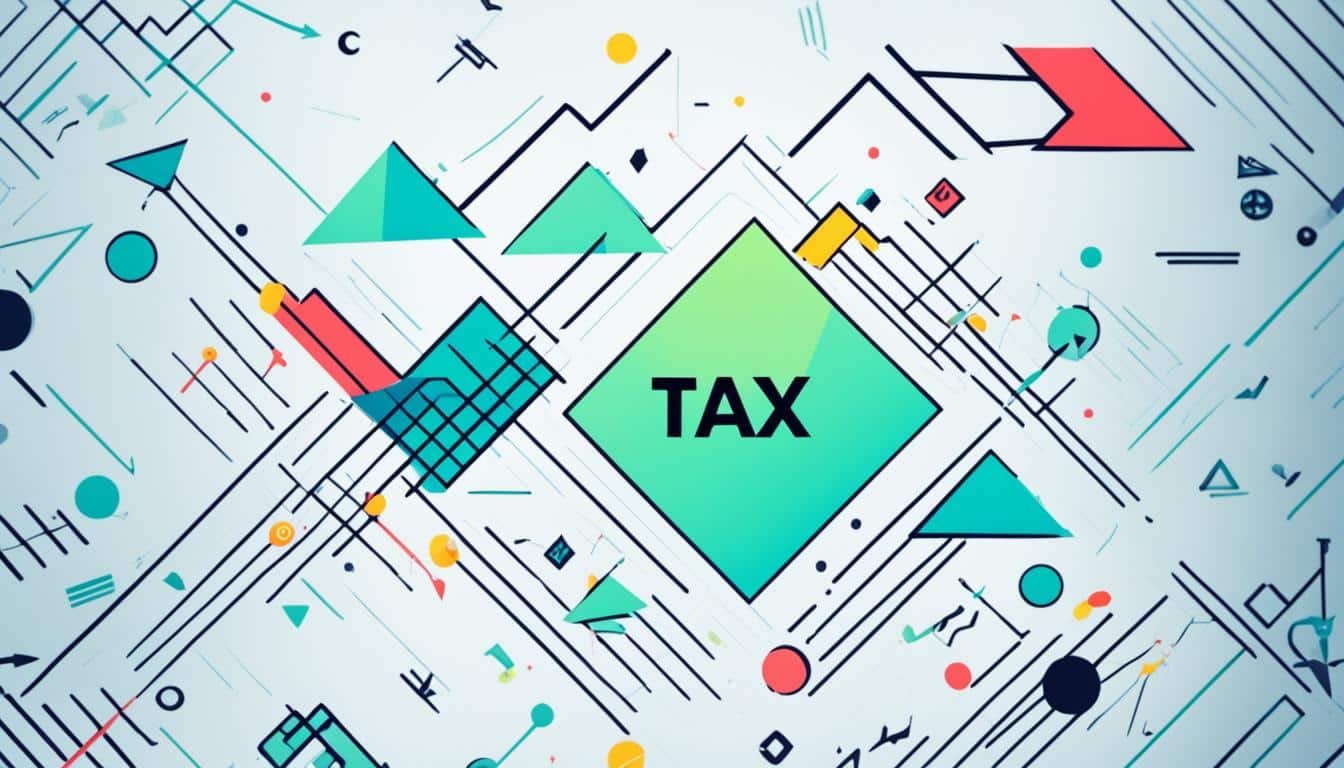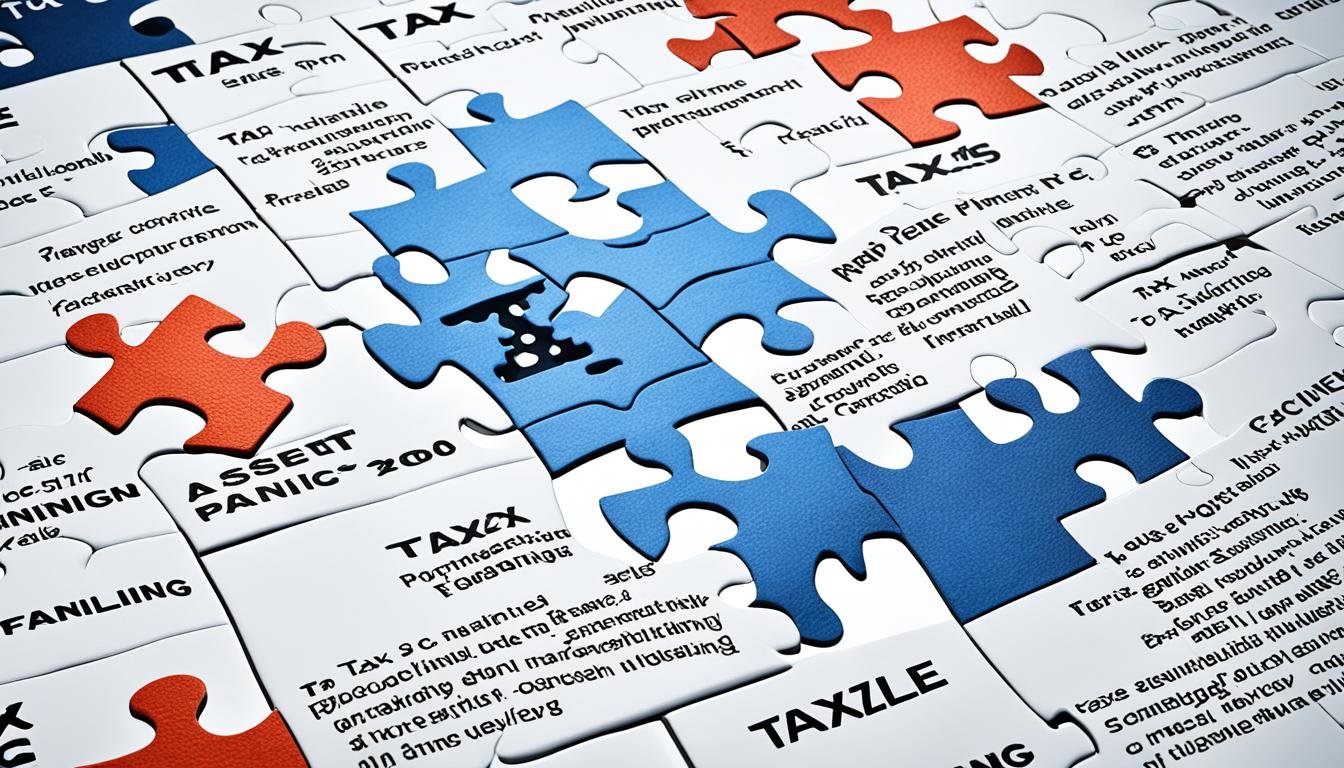How Can Tax Planning Optimize Your Financial Strategy?
Did you know that good tax planning makes sure you get the most tax deductions? It also helps cut down how much tax you have to pay. Plus, it keeps your financial plans in line with your goals. This is key for anyone looking to smartly manage their money.
Key Takeaways:
- Tax planning is a crucial component of a comprehensive financial management strategy.
- It helps individuals and businesses maximize tax deductions and minimize tax liability.
- By aligning financial plans with financial goals, tax planning can optimize your overall financial strategy.
- Understanding tax-saving strategies, deductions, credits, and retirement planning are important aspects of tax planning.
- Working with financial professionals can help ensure effective tax planning and long-term financial success.
The Importance of Tax Planning
Tax planning is key in managing finances well. It helps people and businesses join their financial goals with tax tactics. By knowing how to use deductions and credits, tax planning cuts the tax they owe.
This method lets everyone reduce their tax bill legally. They use these savings to build more wealth or meet other financial goals. It means they pay less in taxes but keep more of their money.
Also, tax planning boosts wealth. It lets you keep more of what you make. With smart tax planning, you can save money and use it wisely towards your dreams.
Doing taxes well is part of good financial management. It makes sure money is spent wisely, helping people and companies reach their money goals. This way, they can use tax savings for important plans like further studies or starting a business.
“Tax planning is the key to unlocking financial potential. By strategically using tax deductions and credits, individuals and businesses can align their financial objectives with their tax strategies, ultimately achieving their financial aspirations.”
But tax planning is not just about owing less to the taxman. It also helps keep your finances in good shape. By using tax benefits wisely, people and companies can manage their money better.
Think about a small business owner. By using tax strategies, they can lower their tax bills. This means more profits and chances to grow their business. They might even create new jobs.
Financial Planning and Tax Planning: A Collaborative Approach
Great financial planning needs teamwork. People work with financial or tax experts to make smart financial plans. This ensures they pay the least tax while reaching their money goals.
“Collaborating with financial professionals can provide the expertise and insight necessary to develop tax-efficient financial plans tailored to individual circumstances. By working together, individuals and businesses can navigate the complexities of tax laws and regulations to optimize their financial strategies.”
Tax planning is vital for overall financial well-being. It’s about using the tax system to your advantage. This way, you keep more of your money and set yourself up for a better financial future.
Key Components of Tax Planning
Effective tax planning involves key steps that help people and companies use their money wisely. They aim to pay less in taxes legally. This is done through knowing what tax breaks are available, when to record income and costs, and how to share earnings within a family.
One important part of tax planning is using tax-saving strategies. This means finding and using tax breaks to lower how much you pay. You can reduce what you owe by making the most of deductible items like work expenses, interest on a mortgage, and donations to charities.
Also, claiming credits for things like having kids or making energy-saving home upgrades can cut your taxes even more.
Deciding when to take money in or pay bills helps too. This is called income timing. By moving income to later times and bills to now, you can lower your taxes. This method is useful when facing higher tax rates or if wanting to make the most of tax breaks.
Income splitting is a way families can pay less in taxes. It means sharing income among family members to lower the overall tax bill. This can be done by setting up a trust, giving some money to a spouse in a lower bracket, or using income from investments made together.
Also, using tax avoidance within legal boundaries is fine. It means arranging your finances to cut your taxes without breaking any laws. For example, choosing tax-friendly investments or using accounts where you pay taxes later can help. But remember, everything you do to pay less in taxes should follow the law.
To wrap it up, tax planning is all about smart financial moves. By knowing and using the tax rules to your advantage, you can keep more of your money. This way, you can work towards your financial dreams and secure your future.
Tax-Planning Strategies for Individuals
There are ways for people to plan their taxes better. By using these techniques, individuals can lower how much tax they pay. This means they keep more of their money. We will look into some important strategies for tax planning:
Maximizing Deductions
Deductions are a great tool to pay less tax. They lower your taxable income, decreasing the tax you owe. Some items you can deduct are your mortgage interest, medical costs, and donations to charity. Keep track of these to make the most of deductions and shrink your tax bill.
Understanding Itemized Deductions versus the Standard Deduction
It’s key to know the difference between itemized and standard deductions. The standard one is a fixed amount you can use without listing specific expenses. Itemized deductions are those specific costs you detail. Decide which option is better for you to save more on your taxes.
Taking Advantage of Tax Credits
Tax credits directly reduce the amount you owe in taxes, unlike deductions. They’re like tax discounts. For example, the child tax credit or earned income credit. Grab all the credits you qualify for to slash your tax bill or boost your refund.
Making Tax-Efficient Investments
Investing in ways that are less taxed can be smart. Use accounts like IRAs and 401(k)s to postpone taxes on your savings. Some investments, such as municipal bonds, can even be tax-free. Picking such options can increase what you keep after taxes.
Planning for Retirement
Planning for your golden years can have tax benefits too. Money put in retirement accounts can be taken off your current taxable income. Also, you usually don’t pay taxes on the account’s earnings until you withdraw the money. This way, you’re preparing for the future and saving on taxes now.
By using these strategies, individuals can make their financial situation better. They can trim their tax bill and save more money.
| Tax-Planning Strategies for Individuals |
|---|
| Maximizing Deductions |
| Understanding Itemized Deductions versus the Standard Deduction |
| Taking Advantage of Tax Credits |
| Making Tax-Efficient Investments |
| Planning for Retirement |
Standard Deduction vs. Itemized Deductions
Tax planning? Knowing the difference between standard and itemized deductions is key. They affect your tax savings based on your finances.
The standard deduction is a fixed amount subtracted from your taxable income. This reduces your taxable amount. It doesn’t matter what you spend money on or how you track it, you can claim this. For 2021, here are the standard deduction amounts:
| Filing Status | Standard Deduction Amount |
|---|---|
| Single | $12,550 |
| Married Filing Jointly | $25,100 |
| Head of Household | $18,800 |
Now, itemized deductions mean you can list certain expenses to deduct. This is more complex and requires careful expense tracking. Examples are local taxes, home loan interest, medical bills, and charity donations.
Taking the standard deduction or listing expenses (itemizing) depends on what saves you more on taxes. If your listed expenses are worth more than the standard amount, itemizing might be better. But, if your listed expenses don’t reach the standard amount, it’s smarter to take the standard deduction.
Remember, tax laws and rules about deductions can change. It’s a good idea to talk to a tax pro or check the latest IRS updates for the best advice.
Significance of Tax Credits
Tax credits are key in a good tax strategy. They work by directly cutting the tax you owe, unlike deductions. This is a big plus for people wanting to lower their taxes and save more money.
They can be used for many life aspects, like for children and dependents. These credits really make a difference, reducing what you owe and offering families financial help.
The Child Tax Credit, for instance, gives a break to families with kids. It lowers the costs of raising kids and offers a needed financial boost. There are also education credits which help with school costs, lowering the tax bill even more.
Using these credits smartly can really help reach financial goals. Always knowing the rules around each credit is key to getting the most out of them.
“Tax credits directly reduce tax liability, making them highly valuable for individuals seeking to minimize their tax burden and maximize savings.”
Understanding how tax credits mix with other tax plans is also essential. Mixing these credits with deductions can lower taxes even more. This is part of making a tax plan that fits your financial aims.
Tax credits offer a strong way to better your tax planning. With credits for your family or for education, you can lower what you owe and save more. This helps in reaching financial dreams and building a safer money future.
Education Savings and Retirement Planning
When thinking about tax planning, the future is as crucial as the present. It’s wise to use education savings plans like the 529 plan. This way, you can prepare for your child’s education and get some tax benefits. Also, looking into retirement options can prepare you for a financially secure future.
529 Plans: Investing in Education
529 plans are designed for saving for education and come with tax benefits. You can save money for education expenses, from tuition to books. Money in a 529 plan grows without being taxed, and no tax is paid when used for educational needs. So, it’s a good way for parents and guardians to save for their child’s schooling.
Starting a 529 plan early and adding to it regularly is smart. This way, you can enjoy the benefits of compounding. You might even avoid student loans. Besides tax perks, it also brings peace of mind, knowing you’re helping with education costs.
Tax-Advantaged Retirement Options
It’s very important to plan for retirement too. Looking into tax-advantaged retirement options helps reduce taxes and save for the future.
A 401(k) is a great way to save for retirement with tax benefits. Money put into a 401(k) isn’t taxed right away. Plus, you might get extra money from your employer. So, it’s smart to make the most of this retirement option.
There’s also the traditional IRA, which offers a tax deduction for savings. Like the 401(k), an IRA lets your money grow without taxes until you withdraw it in retirement. For another option, a Roth IRA lets you pay taxes on the money now, but you won’t pay taxes when you take it out later.
Diversifying your retirement savings with these options is a good plan. It helps you save more and reduces your tax burden. By balancing education and retirement planning, you can secure your future while paying fewer taxes.
A Comparison of Tax-Advantaged Education and Retirement Options
| Tax-Advantaged Option | Contributions | Growth | Withdrawals |
|---|---|---|---|
| 529 Plan | After-tax | Tax-free | Tax-free for education expenses |
| 401(k) | Pre-tax | Tax-deferred | Taxable in retirement |
| Traditional IRA | Tax-deductible | Tax-deferred | Taxable in retirement |
| Roth IRA | After-tax | Tax-free | Tax-free in retirement |
Tax-Planning Strategies for Businesses
Businesses can better plan their taxes by using smart strategies. They can do this by taking advantage of tax deductions and planning when to report income and expenses. They might also plan for how to handle capital gains and losses. Finally, setting up retirement plans for workers is a key part of tax planning.
Qualified Business Income Deduction
The qualified business income deduction is important for businesses. It lets businesses reduce their tax bill by up to 20% of their earnings. To get this break, businesses must meet certain rules and understand how to use the deduction for their best gain.
Income and Expense Timing
Timing is everything when it comes to tax planning. Companies can lower their tax bills by carefully choosing when to show money coming in and going out. For instance, they might delay earning money until the next tax year. Or they could pay expenses early. This can cut the amount they owe in taxes.
Capital Gains and Losses
Deciding when to sell assets can also help businesses save on taxes. By thinking about when to sell and at what profit, businesses can lower their tax bills. They might even be able to cancel out some gains with losses, reducing what they owe.
Retirement Contributions
Offering retirement plans can benefit both companies and their workers. The money companies put into these plans is untaxed. This helps the company save money and gives workers a way to save for the future. There are many types of retirement plans businesses can offer, such as 401(k) plans and SEP IRAs.
| Tax-Planning Strategy | Benefits |
|---|---|
| Qualified Business Income Deduction | Reduction in taxable income, lowering overall tax liability. |
| Income and Expense Timing | Minimization of taxable income through strategic timing of income and expenses. |
| Capital Gains and Losses | Reduction of taxable capital gains and potential offsetting of gains with losses. |
| Retirement Contributions | Double benefit of tax deductions for contributions and helping employees save for retirement. |

Following these tax-planning steps can help businesses save money and do better financially. It’s also wise for companies to work with tax experts. They can get advice that fits their business’s unique plans and goals.
Taking Advantage of Qualified Business Income Deduction
Pass-through businesses can save a lot by smartly using the qualified business income deduction. They choose the best salary for owners to cut self-employment taxes. This way, they save money without any IRS trouble. This tax break lets these businesses keep more of what they earn.
Understanding the Qualified Business Income Deduction
What’s the qualified business income deduction all about? It lets businesses cut up to 20% off their income that can be taxed. This applies to many businesses that don’t pay taxes on their earnings directly.
For small business owners, this deduction is a big deal. It means they get a break almost as good as what big companies enjoy.
Strategic Salary Planning for Pass-Through Business Owners
Choosing the right salary is key for business owners. They aim to balance paying themselves and saving on taxes. This approach helps them keep more money personally while cutting business taxes.
Finding the right salary is important. Too low looks suspicious to the IRS. Too high and you might lose tax benefits. It’s a tricky balancing act.
Maximizing Tax Savings without Raising Red Flags
When figuring out salaries, pass-through businesses must be careful. They don’t want the IRS to think they’re doing something fishy. Salaries should be fair based on what’s normal in the business world.
It really helps to work with tax experts. They make sure you’re playing by the rules. This way, businesses can save on taxes without worry.
| Pass-Through Business with Qualified Business Income Deduction | Pass-Through Business without Qualified Business Income Deduction | |
|---|---|---|
| Taxable Income | Reduced by 20% of QBI (subject to limitations) | Taxed at individual income tax rates |
| Tax Deduction | Significant deduction can lower tax liability | No specific deduction for QBI |
| Self-Employment Taxes | Reduction in self-employment taxes due to lower taxable income | Subject to self-employment taxes on entire taxable income |
Defer or Accelerate Income and Expenses
Small business owners can make smart tax choices by adjusting when they count income and expenses. This strategy uses the cash method of accounting. It helps businesses manage money better and pay less in taxes. By delaying some earnings and costs, companies can lower what they owe in taxes.
The cash method means a business records income when it gets the money and expenses when they’re paid out. This gives companies more say over how much they pay in taxes. They can put off counting money they’ve earned or speed up how they list their costs. Pushing income off to the next tax year might mean paying taxes at a lower rate.
On the flip side, businesses might speed up their spending. This could lower their earnings on paper, meaning less tax owed now. It’s a good move when they’re looking at future tax changes or need to balance out a big year of income.
Remember, altering when you track money coming in and going out has rules. Businesses need to stay within the tax law. They should work with tax pros to get this part right.
Benefits of Deferring and Accelerating
Playing with when you log money and spending can be a big plus for business owners. It can:
- Lower Tax Liability: By cleverly delaying cash in or speeding up spending, businesses can shrink what they owe in taxes.
- Increased Cash Flow: Putting off some earnings can leave more money in their hands this year. This helps with day-to-day spending or investing.
- Improved Tax Planning: It gives businesses the power to plan taxes smartly, based on what they expect next year’s tax rates to be and their money goals.
- Timing Flexibility: Thanks to the cash method, businesses can choose when to report money coming in or going out. This can be based on their unique money situation.
In the end, the cash method offers businesses a way to adjust their income and spending timing. This can cut their tax bill, making things a bit easier on their wallets.
Example:
Imagine a small business owner thinks taxes will go up next year. They might wait to record some money earned till then. This could lower their earnings this year on paper, leading to less tax owed now.
Planning Capital Gains and Losses
Small business owners can use tax gain-loss harvesting for better tax planning. They can balance capital gains by selling assets that have lost value. This helps them cut down on taxes and make more money. Capital gains come from selling assets like stocks, real estate, or businesses. Capital losses happen when the asset value goes down.
Timing the sale of these assets is key. Business owners aim to sell assets with losses to balance out their gains. This lowers their taxable income. The end goal is to have a net capital gain while paying less tax.
Yet, following IRS’ wash sale rules is crucial. These rules stop people from claiming losses if they buy the same asset within 30 days. Breaking these rules can lead to penalties and lost deductions.
Let’s use an example to show how tax gain-loss harvesting can be effective:
Imagine Charles sells some stocks for a $10,000 gain. He then sells another stock at a $5,000 loss to balance this. Now, he only pays taxes on $5,000 of his gains. This means lower tax payments for Charles.
Using this strategy needs careful thought and planning. Business owners might want to talk to tax experts or financial advisors. This ensures they follow the tax laws well while making smart tax decisions.
| Benefits of Tax Gain-Loss Harvesting | Considerations for Tax Gain-Loss Harvesting |
|---|---|
|
|
Conclusion
Tax planning is key to getting the most out of your money and being smart about taxes. With the right tax strategies, both people and companies can lower their taxes, save more, and reach their money goals. Planning early and getting advice from experts is vital for a bright financial future.







